Tom Jung
| Tom Jung | |
|---|---|
| Born |
Thomas Jung Boston, Massachusetts, United States |
| Nationality | American |
| Education | School of the Museum of Fine Arts, Boston |
| Known for | Art Direction, Graphic Design, Illustrator, Storyboard Artist |
| Notable work |
Doctor Zhivago Gone With The Wind Papillon The Man Who Would Be King The Omen Star Wars The Lord of the Rings The Deer Hunter The Empire Strikes Back Raging Bull Once Upon a Time in America |
| Awards |
Key Art Award 1978, 1980. The International Society of Science Fiction Award, 1978 |
Thomas Jung is an American advertising art director, graphic designer and illustrator best known for his movie poster art, and a motion picture storyboard artist.[1][2]
Biography
Early life and career
Tom Jung, a Chinese American, was born, raised and educated in Boston, Massachusetts. After finishing High School he attended the School of the Museum of Fine Arts. During his second year he was drafted into the Army. While stationed at Fort Jackson in Columbia, South Carolina, Jung contributed to the newspaper Fort Jackson Leader as an editorial cartoonist, designing and illustrating primarily public service communications.[3]
Following his discharge, he worked as a freelance illustrator and art director with a number of well known advertising agencies in New York.
In 1958 Jung was hired full-time to redesign advertisement campaigns of foreign films to suit American audiences (theatrical redistribution) for Ben Adler Advertising Services Inc.[4] Jung created pressbooks (exhibitor’s campaign manuals)[5][6] and one sheets for distribution to independently owned movie theaters throughout the country. Jung's work on La Strada[4] and And God Created Woman helped introduce American audiences to the magic and genius of Federico Fellini and Roger Vadim.
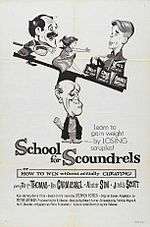
Jung's early work is typified by caricature art for movies such as Bekenntnisse des Hochstaplers Felix Krull, The Captain from Köpenick, The Golden Age of Comedy and Murder Ahoy. His one-sheet art for the film School for Scoundrels is perhaps the best example of that early style, displaying caricatures in shades of black and gray on a white background with distinctive handlettering. The look recalls Jung's own early aspirations of becoming a Mad Magazine cartoonist in the style of such artists as Jack Davis, Mort Drucker and Jack Rickard.

One of Jung's early assignments was the one sheet theatrical poster for the 1959 movie Plan 9 from Outer Space, dubbed the "worst movie ever made" by authors Michael and Harry Medved in their 1980 book The Golden Turkey Awards. Since Jung would go on, in 1977, to design and illustrate the one sheet theatrical poster for one of the most widely acclaimed films ever made, Star Wars, he carries the unusual distinction of having worked on perhaps the worst and best movies made during the last fifty years.
Jung's early successes led eventually to his role as freelance art director in 1963 at Metro-Goldwyn-Mayer, where he designed posters for roadshow or "hard-ticket"[7] movies such as Dr. Zhivago, Grand Prix, Far from the Madding Crowd, Ice Station Zebra, and The Shoes of the Fisherman. The design process at MGM involved developing multiple poster concepts, carefully rendered in pencil or charcoal with or without copy lines and credits in position. These "layouts" were then presented to and scrutinized by Ad manager Bill O'Hare and marketing vice president Dan Terrell for approval as the films Key Art. Once selected, this concept would be the one to appear in newspapers, magazines and in-house stationery, PR communications, all interior and outdoor posting material for distribution in the United States.
Upon final review by MGM chief executive officer Robert O'Brien, the concept was turned over to their advertising agency account executive, Lloyd McKean, to manage implementation. Art Director Burt Kleeger would task the agreed-upon illustrator to prepare a full color painting of the approved image as well as to design various needed parts of the campaign. The advertising agency art department would then prepare "mechanicals" to precise dimensions for the engravers and plate makers for newspaper, magazine and poster printers.

Jung selected Howard Terpning to illustrate his concept art for the 1967 re-release of Gone With The Wind.[8] Taking a cue from the original movie poster art, Jung's iconic pose is often imitated, most notably in the style A poster for The Empire Strikes Back. "I see the results of my design all over," he said. "Gone With The Wind was really notable for its schmaltziness."[8]
In 1968 Jung was engaged by Bill O'Hare, now a marketing executive at CBS television network's theatrical film division Cinema Center Films, to handle the art direction for their entire release schedule of nearly 30 films. Some of the films Jung designed and illustrated, with the help of able staffer and artist Vincent Marrone, were A Man Called Horse, Little Big Man, Prime Cut and Le Mans, starring Steve McQueen.
Later career
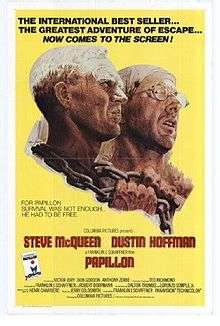
In 1973, Jung's work on the movie Papillon "was the first major break that pushed him into the big-bracket category". "It was obvious that Dustin Hoffman and Steve McQueen had unique roles in Papillon," he recalled. "Steve represented, at that time, a gut of defiance that any person would identify with … defiance against oppression and authority. The poster made with this theme merged perfectly with the mood of the film."[9] An auction profile for the original art gives a synopsis of Jung's concept: "Accomplished in acrylic on a leaf of 17 x 18 ¼ in. artist's illustration board it features the defiant, squinting profiles of Steve McQueen and Dustin Hoffman. Jung commented that although he was a trained illustrator, for 20 years he had acted as art director for ad campaigns and concepts, and not practicing his painting. The present concept study was his first effort to establish a style and was approved by Marketing VP Ed Seigenfeld (Allied Artists, 1973)."[10]
During this time Jung was known to film studios as a one stop shop for advertising. He was handed a project and given full discretion to develop the concept, design and illustration including copy lines and title logos. Jung worked for Allied Artists, United Artists, Columbia Pictures, 20th Century Fox, Paramount Pictures and Lucasfilm Ltd. designing Key Art concepts and illustrating movie posters for films including The Man Who Would Be King, The Deer Hunter, Dr. Zhivago, and Apocalypse Now.
Jung often collaborated with Nelson Lyon, a former Saturday Night Live writer and the creator of the 1971 movie The Telephone Book, to develop copy lines. Jung's unique title logos for movies such as The Sand Pebbles, Super Fly, Gold and The Omen tie in key elements that distill down the essence of the films into Key Art.
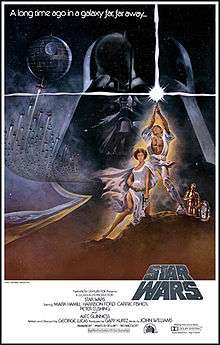
As a freelance illustrator in 1977 working for the motion picture advertising boutique of Smolen, Smith and Connolly, Jung was chosen to work on Star Wars. He was given the theme of "Good Over Evil," and provided with a wealth of photos taken by unit photographers in color and black & white, as well as 2.25-inch stills on contact sheets taken from the original 35mm print of the film. Jung's work was used as the one sheet "style A" theatrical poster for the film's advertising campaign. According to Jung, the unlikely "cross" formed by Luke Skywalker's saber sword set against the ghosted background image of Darth Vader seemed to him like a good solution to the "good" versus "evil" theme.[11][12] The poster also featured a notable title logo from Jung, mimicking the film's famed opening crawl.
.jpg)
A stylistic progression in Jung's art is clear from his 1978 work on The Lord of the Rings. One of two concepts submitted, the one sheet depicting Gandalf and the Hobbits Frodo and Sam is rendered in a style markedly different from Jung's other works. In his own words: "There's probably a lot of posters I've done that people aren't aware of: Papillon, The Man Who Would Be King, and … for Lord of the Rings."[8] Jung's poster won first prize for Best Graphic Award in 1978 from the International Society of Science Fiction, Horror and Fantasy, and has been called "truly the most well-remembered image" from the film.[13]
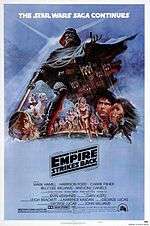
Regarding his 1980 work on The Empire Strikes Back, Jung recalled: "I used various martial arts attitudes in my working studies, trying to come up with the perfect look. I was searching for the image 'bi-coastal' (as they used to say) of Darth Vader, which could be the centerpiece for The Empire Strikes Back. I made the presentation to Sid Ganis at Lucasfilm's new offices in North Hollywood, near Universal Studios. In the large airy reception area sitting on couches, with my presentation spread on a coffee table, we attracted a small crowd of onlookers. Steven Spielberg peered in and chimed, 'I like that' and strolled away. It was the drawing of Darth Vader in profile, a powerful outstretched arm holding his saber."[11]
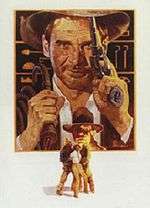
In 1981 Jung was contacted by Sid Ganis, vice president of marketing at Lucasfilm, to develop concept sketches for Raiders of the Lost Ark. At the same time the production company, Paramount Pictures along with advertising agency Diener/Hauser/Bates, were working with another illustrator, Richard Amsel, to also develop a marketing campaign. Jung created sixteen concept sketches for the one-sheet, one of which was approved to go to color.[14] Borrowing from his original Papillon artwork, Jung used a "brown sauce" palette and a unique concept to create the iconic character Indiana Jones for his interpretation of the movies Key Art.[14]
After many months of back and forth between competing concepts it was decided that Richard Amsel's would be used as the one-sheet for the campaign. The decision was partly based on the view that the character Indiana Jones should not be shown with a gun. In Jung's art, a gun and a whip were both prominently held by Indiana Jones. Jung's concept, though not used during the film's advertising campaign, is preserved in the Lucasfilm archives.[15]
Starting in 1997 with the Disney film Jungle 2 Jungle, Jung began working on the production side of the business as a storyboard artist.[16] His ability to draw without the use of visual aids, in a manner similar to that of a comic book artist, made his transition to storyboard art unproblematic. Jung's films as a storyboard artist include The Perfect Storm, The Salton Sea and Disturbia.
Creative process
An interview with Jung on the design and illustration of the 1974 poster The Man with the Golden Gun elaborated on his creative process: "The actual painting is done on 20x30 double-weight illustration board, half of a standard 30x40 board. I used acrylics, I can use it transparently or opaquely; it dries quickly and is permanent and can be reworked. I'd use airbrushing for large areas of background, color pencils, and inks and dyes and tempera and whatever else I think that may give me the desired result. Sandpaper. Brillo. A single-edge razor blade. Whatever works."[17] Jung often used family members as models. For the Star Wars poster design, with Frank Frazetta in mind as his final illustrator, Jung posed his son Jeff as Luke Skywalker and his wife Kay as Princess Leia.[8] After discussions with Don Smolen of Smolen, Smith and Connolly, it was decided that Jung would execute the illustration.
Jung has said he believes he does not have a recognizable technique. "I adjust my technique to the problem at hand, because being an art director in advertising it's really the end result that I'm after … anything to get the printed poster and the printed ad, which is the primary goal".[8]
Select illustrations and graphic design
| Date | Project[18] | Notes |
|---|---|---|
| 1954 | La Strada[4] | US release, Pressbook including one-sheet |
| 1955 | Death of a Cyclist | US release (Age of Infidelity), Pressbook including one-sheet |
| 1956 | Liane, Jungle Goddess | US release, Hand lettering design and illustration |
| 1956 | The Captain from Koepenick | US release, Pressbook including one-sheet |
| 1956 | The Sword and the Cross | US release, Pressbook including one-sheet |
| 1957 | And God Created Woman | US release, Key Art |
| 1957 | Confessions of Felix Krull | US release, Pressbook including one-sheet |
| 1957 | Monpti [19] | US release (Mon Petit), Pressbook including one-sheet |
| 1957 | The Golden Age of Comedy | Eileen Schutz Artist |
| 1957 | The Prince and the Showgirl[19] | Key Art |
| 1958 | Cat on a Hot Tin Roof | |
| 1958 | Yankee Doodle Dandy | Re-Release, Pressbook including one-sheet |
| 1959 | Go, Johnny Go! | Pressbook including one-sheet |
| 1958 | Hippodrome | Pressbook including one-sheet |
| 1959 | Plan 9 from Outer Space | Pressbook including one-sheet, David Lewis Artist |
| 1959 | Room at the Top | Pressbook including one-sheet |
| 1960 | Day of the Painter | Promotional Marketing Campaign |
| 1960 | School for Scoundrels | |
| 1961 | Anna's Sin | |
| 1963 | Murder at the Gallop [19] | |
| 1963 | The Day and the Hour | US Release |
| 1963 | The Wheeler Dealers[19] | Key Art |
| 1964 | Murder Ahoy | |
| 1964 | Murder Most Foul | |
| 1964 | The Big Parade of Comedy [19] | |
| 1964 | The Outrage | Sanford Kossin Artist |
| 1964 | The Unsinkable Molly Brown | Promotional Record Album |
| 1964 | The Young Lovers (1964 film) | |
| 1965 | Lady L | Robert McGinnis Artist |
| 1965 | Doctor Zhivago | Howard Terpning Artist |
| 1966 | Grand Prix | Howard Terpning Artist |
| 1966 | Hotel Paradiso | Frank Frazetta Artist |
| 1966 | The Sand Pebbles[9] | Graphics design one-sheet, Original Soundtrack and opening credits [20][21] |
| 1967 | Far from the Madding Crowd | Howard Terpning Artist |
| 1967 | Gone With The Wind (re-release)[19] | One-sheet, Original Soundtrack. Howard Terpning Artist |
| 1967 | The Venetian Affair | Frank McCarthy Artist |
| 1967 | Tony Rome | Teaser Poster |
| 1968 | Ice Station Zebra | Howard Terpning Artist |
| 1968 | Mayerling | |
| 1968 | The Shoes of the Fisherman | Howard Terpning Artist |
| 1969 | The Royal Hunt of the Sun | Howard Rogers Artist |
| 1970 | A Man Called Horse | Vincent Marrone Artist |
| 1970 | Scrooge | Joseph Bowler Artist |
| 1970 | Kelly's Heroes | Jack Davis Artist |
| 1971 | Le Mans | |
| 1972 | Prime Cut | |
| 1972 | Super Fly | One-sheet, Original Soundtrack. |
| 1972 | The Little Ark | Arthur Lidov Artist |
| 1972 | The Revengers | |
| 1973 | Papillon[19] | One-sheet, Original Soundtrack |
| 1973 | White Lightning | |
| 1974 | Gold | |
| 1974 | Huckleberry Finn | David Blossom Artist |
| 1974 | The Day of the Dolphin | |
| 1974 | The Man with the Golden Gun[22] | |
| 1974 | The Spikes Gang | |
| 1974 | The Towering Inferno | |
| 1975 | Bite The Bullet | Style A and B |
| 1975 | Brannigan | Robert McGinnis Artist |
| 1975 | Lucky Lady | |
| 1975 | Report to the Commissioner | |
| 1975 | The Man Who Would Be King[19] | One-sheet, Original Soundtrack |
| 1975 | The Old Gun | |
| 1975 | Smile[19] | Key Art |
| 1976 | Bound for Glory | Style A and B, Original Soundtrack |
| 1976 | Burnt Offerings | |
| 1976 | Shout at the Devil | |
| 1976 | The Omen | Teaser, Co-designer Murray Smith. Style F and Original Soundtrack |
| 1977 | March or Die | |
| 1977 | Star Wars[19] | Style A, Style B (Hildebrandt) designer, Half-sheet, Re-releases 1979, 1981, 1982, 1997 Trilogy designer, Original Soundtrack back cover and promotional poster. |
| 1978 | F.I.S.T.[19] | Key Art |
| 1978 | The History of Country Music[23] | Commercial use, Distributed to radio stations. Poster and album cover. |
| 1978 | The History of Rock & Roll[23] | Commercial use, Distributed to radio stations. Poster and album cover. |
| 1978 | King of the Gypsies | Style A and B, Sanford Kossin Artist Style B |
| 1978 | The Deer Hunter | Saul Cooper Initial Concept |
| 1978 | The Great Train Robbery | |
| 1978 | The Greek Tycoon | David Blossom Artist |
| 1978 | The Lord of the Rings | Style A and B |
| 1978 | Who'll Stop the Rain | |
| 1979 | Apocalypse Now[19] | Co-designer, Bob Peak Artist |
| 1980 | Heaven's Gate | |
| 1980 | Raging Bull | Style B, Co-artists Kunio Hagio and Paul Gross |
| 1980 | The Dogs of War[19] | |
| 1980 | The Empire Strikes Back[19] | Style B and re-releases 1981, 1982 |
| 1980 | The Formula | One-sheet, Original Soundtrack |
| 1981 | Raiders of the Lost Ark | Key Art |
| 1981 | Whose Life Is It Anyway[19] | |
| 1983 | Return Of The Jedi | Re-release 1985, One sheet with Death Star exploding |
| 1983 | Scarface[24] | Key Art |
| 1983 | The Right Stuff | One-sheet, Original Soundtrack |
| 1984 | Dune[24] | Designer |
| 1984 | Once Upon a Time in America | Artist Syle A, B and C. U.S. and foreign advertising campaigns |
| 1984 | The Buddy System | |
| 1984 | The Razor's Edge | |
| 1985 | Sylvester | |
| 1985 | Weird Science | Duane Meltzer Artist |
| 1986 | Clockwise | Duane Meltzer Artist |
| 1986 | Heat[19] | Key Art |
| 1987 | Flowers in the Attic | Co-designer Nelson Lyon |
| 1988 | Pass the Ammo | Co-designer Ken Goodman |
| 1989 | Moontrap | |
| 1989 | The Iron Triangle | |
| 1991 | Star Trek 25th Anniversary | |
| 1991–1993 | The Thrawn Trilogy | Book Cover Art - Heir to the Empire,[19] Dark Force Rising, The Last Command,[19] Promotional Poster |
| 2012 | Wallenda | Shawn Hull Artist |
Select storyboard artwork
The key skill: "One thing a storyboard artist needs to be able to do is be able to draw out of his head. There are many illustrators who have to rely on photographs, but unless you can draw out of your head like comic book artists, I don't think you can do it. … Normally, a storyboard artist is only called in when they are looking for special effects or action shots. But sometimes you have a guy like Alfred Hitchcock, he wouldn't even trust the camera and he would visualize every single shot."
Tom Jung in The Los Angeles Times, 2007[25]
| Date | Project[24] |
|---|---|
| 1977 | The Baron |
| 1996 | Mrs. Santa Claus (Trailers) |
| 1996 | Ransom (Trailers) |
| 1997 | Jungle 2 Jungle |
| 1997 | The Relic (Trailers) |
| 1998 | Chairman of the Board (Trailers) |
| 1998 | Doctor Dolittle |
| 1999 | My Favorite Martian |
| 1999 | Stuart Little |
| 2000 | The Adventures of Rocky and Bullwinkle |
| 2000 | Nutty Professor II: The Klumps |
| 2000 | The Perfect Storm |
| 2001 | Hannibal (Trailers) |
| 2002 | Collateral Damage |
| 2002 | Frank McKlusky, C.I. |
| 2002 | Master Spy: The Robert Hanssen Story |
| 2002 | Slackers |
| 2002 | Star Trek Nemesis |
| 2002 | Stuart Little 2 |
| 2002 | The Salton Sea |
| 2003 | The Haunted Mansion |
| 2003 | Looney Tunes: Back in Action |
| 2003 | Hulk |
| 2003 | Holes |
| 2003 | Just Married |
| 2004 | First Daughter |
| 2004 | Scooby-Doo 2: Monsters Unleashed |
| 2004 | Starsky & Hutch |
| 2005 | Herbie Fully Loaded |
| 2005 | Two for the Money |
| 2005 | Underclassman |
| 2006 | Zoom |
| 2007 | Disturbia |
| 2007 | Blades of Glory |
| 2012 | Wallenda[26][27] |
Awards
- The International Society of Science Fiction, Horror and Fantasy, "Best Graphic Award", 1979, Lord of the Rings.
- Key Art Award, Tom Jung, designer, illustrator, "El Francotirador": (The Deer Hunter) Latin America, Third Place, 1980.
- Key Art Award, Creating and illustrating The Golden Years of Country, 1978.[23]
See also
References
- ↑ The Star Wars Poster Book, Stephen J. Sansweet, Chronicle Books (October 13, 2005)
- ↑ The Making of Star Wars: The Definitive Story Behind the Original Film, J.W. Rinzler, LucasBooks (April 24, 2007)
- ↑ Fort Jackson Leader newspaper 12/31/1953, U.S. Army Basic Combat Training Museum archives, Columbia, South Carolina
- 1 2 3 CineFiles, University of California, Berkeley Art Museum & Pacific Film Archive http://www.mip.berkeley.edu/cinefiles/DocDetail?docId=37613
- ↑ MovieArt.net
- ↑ AllMovieReplicas.com
- ↑ Movie Roadshows: A History and Filmography of Reserved-Seat Limited Showings, 1911-1973, Page 4, Kim R. Holston, McFarland (December 18, 2012)
- 1 2 3 4 5 Star Wars, Selling The Force by Lawrence French, CINEFANTASTIQUE, Issue #124 - Vol 28 #7, 1997
- 1 2 Visiting artist draws the movies by David Prabu, Athens NEWS contributor - courtesy of Daniel Saez, Athens (Ohio) News - Spring 1987 http://www.thesandpebbles.com/tom_jung/tom_jung.html
- ↑ Profiles in History auction, Lot 588 (April 30, 2009) http://www.liveauctioneers.com/item/6321305
- 1 2 Profiles In History auction (March 31, 2006)
- ↑ TheForce.net review of Star Wars Style A poster http://www.theforce.net/collecting/posters/anh/style-a.asp
- ↑ Profiles in History auction, Lot 639 (December 15, 2006)
- 1 2 The Complete Making of Indiana Jones: The Definitive Story Behind All Four Films, Page 123, J.W. Rinzler, Del Rey (May 20, 2008)
- ↑ Profiles in History auction, Lot 360 (July 28, 2006)
- ↑ The Internet Movie Database, Tom Jung http://www.imdb.com/name/nm2200560/
- ↑ Illustrated007, Peter Lorenz, 2010 http://illustrated007.blogspot.com/2010/04/exclusive-with-tom-jung.html
- ↑ Academy of Motion Picture Arts and Sciences, Margaret Herrick Library Catalog, Tom Jung
- 1 2 3 4 5 6 7 8 9 10 11 12 13 14 15 16 17 18 Academy of Motion Picture Arts and Sciences, Margaret Herrick Library Production Art Database, Tom Jung
- ↑ Video of opening credits with Tom Jung's graphic design of American gunboat superimposed over a Chinese junk for the motion picture The Sand Pebbles https://www.youtube.com/watch?v=m2MvjJ-XpK0
- ↑ Video of promotional preview with Tom Jung's graphic design of American gunboat superimposed over a Chinese junk for the motion picture The Sand Pebbles https://www.youtube.com/watch?v=0jjjvfk-d_w
- ↑ Illustrated 007, Man With The Golden Gun - Concept Art http://illustrated007.blogspot.com/2009/10/man-with-golden-gun-concept-art.html
- 1 2 3 Drake-Chenault radio syndication company http://www.drakechenault.org/special.html
- 1 2 3 Academy of Motion Picture Arts and Sciences, Margaret Herrick Library Catalog, Tom Jung Papers
- ↑ Sketching out the action, he loves making a scene - The Los Angeles Times, Susan King - May 20, 2007 http://articles.latimes.com/2007/may/20/entertainment/ca-working20
- ↑ Rareform Pictures, Wallenda production http://rareformpictures.com/production.html
- ↑ Rareform Pictures, Tom Jung Wallenda storyboards http://www.flickr.com/photos/rareformpictures/6839575067/in/photostream
Interviews
- Visiting artist draws the movies by David Prabu, Athens NEWS contributor - courtesy of Daniel Saez, Athens (Ohio) News - Spring 1987
- Exclusive with Tom Jung - "The Man with the Golden Gun", Illustrated 007 Peter Lorenz
- Sketching out the action, he loves making a scene - The Los Angeles Times, Susan King - May 20, 2007
- Rebelscum.com forum, darthlumber ID, January 30, 2010
- Artistic License, a look at the marketing campaign for "Licence Revoked" - MI6 Confidential, Issue #26 - August 2014
External links
- The Academy of Motion Picture Arts and Sciences, Margaret Herrick Library Catalog, Tom Jung
- The Academy of Motion Picture Arts and Sciences, Margaret Herrick Library Catalog, Tom Jung Papers
- The Academy of Motion Picture Arts and Sciences, Margaret Herrick Library Manuscript Inventories, Tom Jung
- The Academy of Motion Picture Arts and Sciences, Margaret Herrick Library Production Art Database, Tom Jung
- Sciencefictionarchives.com Preliminary design, Star Wars
- Sciencefictionarchives.com Preliminary design, The Empire Strikes Back
- Sciencefictionarchives.com Preliminary design, Return of the Jedi
- Movieposterdb.com Select listing of Tom Jung's art
- IMPawards Select listing of Tom Jung's art
- Tom Jung at the Internet Movie Database